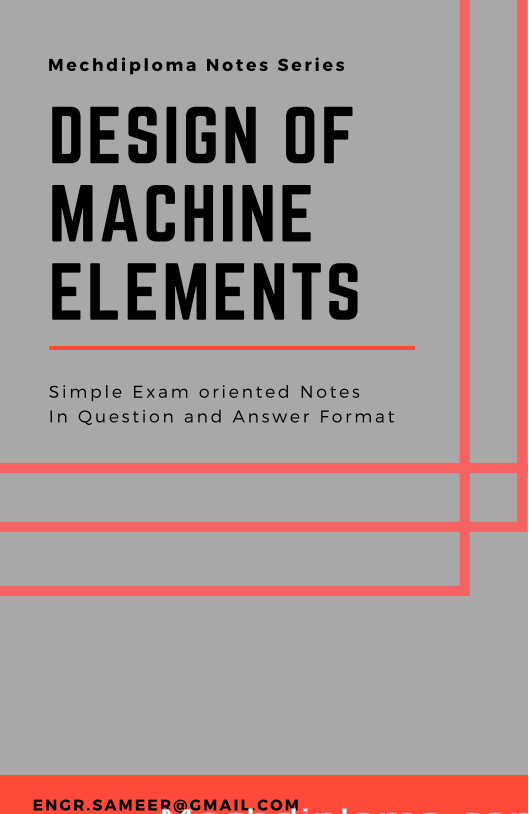17610 Design of machine element msbte model answer paper
-_-_-_-_-_-_-_-_-_-_
Course Name : Diploma in Mechanical Engineering
Course code : ME/MH/MI
Semester : Sixth for ME and Seventh for MH/MI
Subject Title : Design of Machine Elements
Subject Code : 17610
| Type | View | Size | |
|---|---|---|---|
| | 17610 -Sample Question Paper for G scheme.pdf | View | 41.34 KB |
Pages
Topic 1: Introduction to Design
Specific Objectives:
State the need for the design
List all parameters related to design
Apply basic concepts in design procedure
1.1 Basic Design Considerations 04 Marks
Design philosophy and Procedures
General Considerations in Design
Types of loads, concepts of stress ,strain, Stress – Strain Diagram for
Ductile and Brittle Materials, Types of Stresses such as Tension,
Compression, Shear, Bearing pressure
Intensity, crushing, bending and torsion, Principle Stresses (Simple
Numericals)
Concept of Creep, Fatigue, S-N curve, Endurance Limit.
1.2 Factors in Design 04 Marks
Factor of Safety and Factors affecting its selection
Stress Concentration – Causes & Remedies
Converting actual load or torque into design load/torque using design
factors
1.3 Properties of Engineering materials 04 Marks
Designation of materials as per IS and introduction to International
standards, advantages of standardization, use of design data book, use
of standards in design and preferred numbers series.
1.4 Theories of Elastic Failures 04 Marks
Principal normal stress theory, Maximum shear stress theory &
maximum distortion energy theory.
1.5 Modern Design considerations 04 Marks
Design for safety, Ecology, societal consideration & Concept of
Product Design, System Design & Creativity in Design, Ergonomics
and aesthetic considerations in design
12 20
Topic 2: Design of Joints, Levers & Offset Links
Specific Objectives:
Design a joint for a given load to be transmitted
Calculate dimensions of lever/link using allowable bending and shear
stress
2.1 Design of Cotter Joint, Knuckle Joint, Turnbuckle 06 Marks
2.2 Design of Levers:- Hand/Foot Lever & Bell Crank Lever, 06 Marks
Lever for lever safety valve, Design of Off-set links, C - Clamp,
Overhang Crank.
08 12
w.e.f Academic Year 2012-13 ‘G’ Scheme
MSBTE - Final Copy Dt. 21/11/2014 17610 ME6 21
Topic 3. Design of Shafts, Keys and Couplings
Specific Objectives:
Design the diameter of a shaft on the basis of equivalent
twisting/bending moment and allowable shear stress
Design the section of most commonly used rectangular key on the
basis of torque transmitted, allowable shear stress and crushing stress
Design a rigid/flexible coupling for connecting two shaft on the basis
of torque and allowable shear stress
Design spur gear by taking into account effective tooth load
3.1 Design of shaft 06 Marks
Types of Shafts, Shaft materials, Standard Sizes,
Design of shafts (Hollow and Solid) using strength and rigidity
criteria,
ASME code of design for line shafts supported between bearings with
one or two pulleys in between or one overhung pulley
3.2 Design of key 04 Marks
Types of keys
Design of rectangular, parallel sunk keys,
Effect of Keyways on strength of shaft.
3.3 Design of Couplings 06 Marks
Flanged couplings – unprotected and protected types
Bush-pin type flexible coupling.
3.4 Design of spur gear 08 Marks
Lewis equation for static beam strength of spur gear teeth
Power transmission capacity of spur gears in bending
Gear tooth failure modes – Scoring, scuffing Pitting & Teeth
Breakage
14 24
Topic 4: Design of Power Screws
Specific Objectives:
Draw the different thread profiles used in power screws and state their
merits and demerits
Bring out the difference between self locking and overhauling
Design the screw jack/toggle jack under a given loading conditions.
4.1 Basic concepts
Thread Profiles used for power Screws, relative merits and demerits of
each, Self locking and overhauling properties
Torque required to overcome thread friction, efficiency of power
screws, types of stresses induced. 06 Marks
4.2 Design of Screw Jack, Toggle Jack (only screw and nut). 06 Marks
10 12
Topic 5: Design of springs
Specific Objectives:
Classify the springs on the basis of different criteria
Design Helical spring based on given load conditions
5.1 Classification and Applications of Springs, Spring - terminology,
materials specifications. Stresses in helical tension and compression
springs, Wahl’s correction factor, Deflection of springs, Energy stored in
springs. 04 Marks
5.2 Design of Helical tension and compression springs subjected to concentric
applied loads like I.C. engine valves, weighing balance, railway buffers
08 12
w.e.f Academic Year 2012-13 ‘G’ Scheme
MSBTE - Final Copy Dt. 21/11/2014 17610 ME6 22
and governor springs. 06 Marks
5.3 Leaf springs - construction and applications 02 Marks
Topic 6: Design of Threaded and Welded Joints
Specific Objectives:
State the applications of fasteners
Design threaded/welded joints under different load conditions
6.1 Stresses in Screwed fasteners, bolts of Uniform Strength, Design of
Bolted Joints subjected to eccentric loading. 06 Marks
6.2 Design of parallel and transverse fillet welds, axially loaded symmetrical
section, Merits and demerits of screwed and welded joint 06 Marks
08 12
Topic 7: Antifriction Bearings
Specific Objectives:
Classify the bearings
Select rolling bearings, for specific applications, using manufacturers
catalogue.
Classification of Bearings – Sliding contact & rolling contact.
Terminology of Ball bearings – life load relationship, basic static load
rating and basic dynamic load rating, limiting speed. Selection of ball
bearings using manufacturer’s catalogue.
